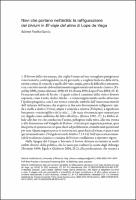Chapter Navi che portano nell’aldilà: la raffigurazione del bivium in El viaje del alma di Lope de Vega
Abstract
The bivium of human life, narrated in the myth of Hercules and symbolized by the Pythagorean Y, was a recurring motif in Spanish theater since the second half of the sixteenth century. Lope de Vega already developed it in one of his most remote sacramental plays, Comedia del viaje del hombre. In Viaje del alma, auto sacramental of Lope composed around 1599, on the occasion of the double royal wedding of Philip III with Margaret of Austria and the infanta Isabella Clara Eugenia with the archduke Albert of Austria, and published in El peregrino en su patria, the crossroads is represented through two opposing ships, of which the playwright offers us an accurate description that has its origin in the iconographic tradition in force at the time


 Download
Download Web Shop
Web Shop